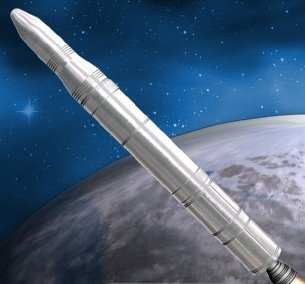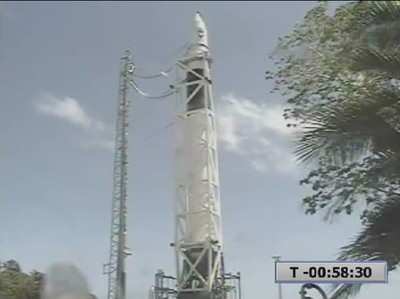Second Stage Roll Control Issue Mars
Otherwise Flawless Launch
 ANN REALTIME
UPDATE 03.20.07 2155 EDT: It looked so good to start...
but problems apparently crept up five minutes into Tuesday
night's launch of SpaceX's Falcon I rocket.
ANN REALTIME
UPDATE 03.20.07 2155 EDT: It looked so good to start...
but problems apparently crept up five minutes into Tuesday
night's launch of SpaceX's Falcon I rocket.
Company founder Elon Musk told reporters the Falcon
I successfully reached space, "and retired almost all the risk
associated with the rocket."
Musk states all went well through stage two separation and
rocket ignition... but problems arose with roll control in the
later portion of the second stage burn. A
progressive oscillation was apparent in the video feed
from the second stage, and the rocket appeared to roll just as
contact was lost.
The exact fate of the second stage isn't known... only that the
rocket made it to approximately 984,000 feet altitude, after which
point the engine shutoff.
The stage did not reach the desired orbit, and Musk said it's
likely the rocket reentered the atmosphere after about
one-half orbit.
Reiterating this was a test launch, Musk said he feels many
concerns about SpaceX's ability to launch rockets have been
answered by today's events.
"All in all, we feel pretty good about this launch," Musk said.
"I'm pretty happy, but nervewracked."
Previous Reports
 2115 EDT:
"Everything looks awesome!" With this statement -- by SpaceX VP for
Business Development Gwynne Shotwell -- SpaceX's Falcon 1 rocket
successfully lifted off the pad, and ascended beautifully into the
skies over Kwajalein Atoll.
2115 EDT:
"Everything looks awesome!" With this statement -- by SpaceX VP for
Business Development Gwynne Shotwell -- SpaceX's Falcon 1 rocket
successfully lifted off the pad, and ascended beautifully into the
skies over Kwajalein Atoll.
Three minutes after launch, applause erupted in mission control
as the first stage separated on schedule, and the second-stage
rocket successfully fired... and launched both a new rocket, and a
new commercial space launch company, into orbit.
Like we said at the beginning of today's report... if at first
you don't succeed...
2050 EDT: Refueling preparations are now
underway on Kwajalein Atoll... and SpaceX representatives tell ANN
the company will make its second launch attempt in about 25
minutes.
Officials with the company have confirmed a lower-than-ideal
chamber pressure reading led the rocket to abort its own launch.
Warmed RP-1 rocket fuel has been pumped into the rocket, along with
more liquid oxygen, and SpaceX does not expect the situation to
repeat itself.
2020 EDT: Recycle! That word means SpaceX will
try again... TODAY... to launch its Falcon 1 rocket, following a
dramatic abort at T-plus-one-seconds less than 20 minutes ago.
This is why this business is fun... stay tuned to ANN for the
latest updates!
2005: Seconds after main engine ignition on the
SpaceX Falcon I rocket, the engine shut down and launch was
aborted, apparently in response to a warning signal from the
rocket.
Early indications point to chamber pressure just .01
percent out of minimum parameters at launch as the
reason for the abort.
The rocket is intact, and SpaceX is currently evaluating the
condition of the vehicle.
1900 EDT: There has been a 65-minute delay to
the launch of the SpaceX Falcon 1 rocket, due to continued testing
of the RF receiver that captures telemetry data as part of the
Tracking and Data Relay Satellite System (TDRSS) onboard the launch
vehicle.
Launch time is now 2005 EDT.
1200 EDT: If at first you don't succeed, try
again. We imagine this aphorism is very much on the minds of the
gang at SpaceX, who moments ago told ANN they'll once again attempt
to launch their Falcon 1 rocket from Kwajalein Atoll, after a
communications glitch led mission control to scrub Monday's launch attempt with
just over one minute left to go in the countdown.
Launch is scheduled for 1900 EDT Tuesday. Be sure to check ANN
often for the latest updates. In the meantime, here is SpaceX
founder Elon Musk's explanation of the events that scrubbed
Monday's launch attempt:
The abort that occurred a few minutes before T-0 was
triggered by our ground control software. It commanded a switchover
of range telemetry from landline to radio, which took place
correctly, however, because of the hardware involved, this
transition takes a few hundred milliseconds. Before it had time to
complete, our system verification software examined state and
aborted.
Our simulations done beforehand all passed, because the
simulator did not account for a hardware driven delay in the
transition. We considered putting the vehicle into a safe state
yesterday and updating the ground control software to make the
very minor fix needed, but the safer course of action was to stand
down.

Yesterday afternoon and evening (Kwaj time), our launch team
updated the software to address the timing issue and verified that
there were no similar problems elsewhere. We ran the software
through several simulated countdowns and then once again with the
rocket and range in the loop.
All systems are now go for launch with T-0 at 4pm California
time today (Tues).
 Aero-TV: DeltaHawks Diesel Power Steps Into the Spotlight
Aero-TV: DeltaHawks Diesel Power Steps Into the Spotlight NTSB Prelim: Mooney Aircraft Corp. M20K
NTSB Prelim: Mooney Aircraft Corp. M20K ANN FAQ: Turn On Post Notifications
ANN FAQ: Turn On Post Notifications ANN's Daily Aero-Linx (12.20.25)
ANN's Daily Aero-Linx (12.20.25) Aero-News: Quote of the Day (12.20.25)
Aero-News: Quote of the Day (12.20.25)





